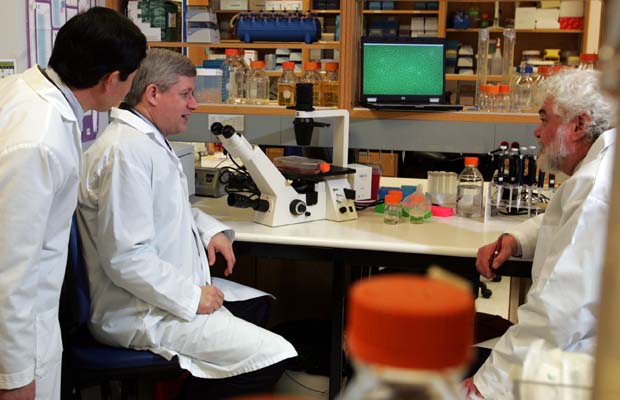
Documents reveal leaks and spills at national virus lab
Jen Skerritt, Winnipeg Free Press
But new documents reveal Canada's National Microbiology Lab isn't immune to leaks, spills and failures in restricted areas where lethal organisms are housed.
Prime Minister Stephen Harper visited Canada's National Microbiology Laboratory last year. Health Canada documents obtained through an access-to-information request reveal close to 250 internal incidents — ranging from equipment failures to potential chemical exposures — were reported in the lab between 2005 and 2009. Also pictured are (right) Dr. Frank Plummer, Scientific Director General and Dr. Yan Li (left), Chief of the Influenza and Respiratory Viruses Section which was doing research on the H1N1 flu virus at the time.
Photograph by: Wayne Glowacki, Winnipeg Free Press
Health Canada documents obtained through an access-to-information request reveal close to 250 internal incidents — ranging from equipment failures to potential chemical exposures — were reported in the lab between 2005 and 2009.
The incidents range in severity and include benign finger cuts, potential exposures to chemicals and viruses such as avian influenza, and equipment failures in Level 3 and 4 containment labs.
One 2006 incident resulted in a person exposed to a "negligible" amount of a Level 4 pathogen. Problems with the air system in a Level 4 lab surfaced twice in 2008, and in the first six months of last year there were eight equipment failures in the same Level 3 containment lab.
Level 4 has the highest level of safety and security.
While the incidents are reviewed by a federally appointed community-liaison committee, they are only made public at the committee's discretion.
New Democrat MP Pat Martin said he was "surprised and disappointed" to hear of the large number of internal incidents reported in the lab during a short period of time. Martin said he wants to see the community liaison committee convene a special public meeting to review the incidents and determine whether the facility is operating in a safe manner.
"I'm quite taken aback that there's been that number of incidents when we've been assured a state-of-the-art facility has state-of-the-art protocols," Martin said.
"Any reported incident is a big deal when you're dealing with the world's most deadly toxins and viruses."
Scientific director Dr. Frank Plummer said most of the incidents likely aren't of interest to the general public and that he isn't aware of any lab employee who has been infected or harmed from an accidental exposure or needle stick. He said the federal facility is constantly reviewing its safety protocols to protect against major incidents.
He admitted that "sometimes we've had a door break on the access to a Level 4 lab," but said the breakdowns are always dealt with immediately and reported to the liaison committee.
"I'm pretty confident we have as safe a laboratory as we can right now," Plummer said.
"Systems fail and sometimes people have accidents and make mistakes."
Security breaches at the federal lab made headlines last year after no one noticed 22 vials of biological material went missing from the high-security facility for four months. A former vaccine researcher was arrested by FBI special agents after U.S. Customs discovered the vials stuffed in a glove in the trunk of his car at the Manitoba-North Dakota border crossing.
Some of the vials included genes from the deadly Ebola virus, which local scientists later said were not infectious.
The theft was included as part of the newly-obtained documents detailing the internal lab incidents.
www.vancouversun.com/health/Documents+reveal+leaks+spills+national+virus/2619532/story.html
Feb. 26, 2010

